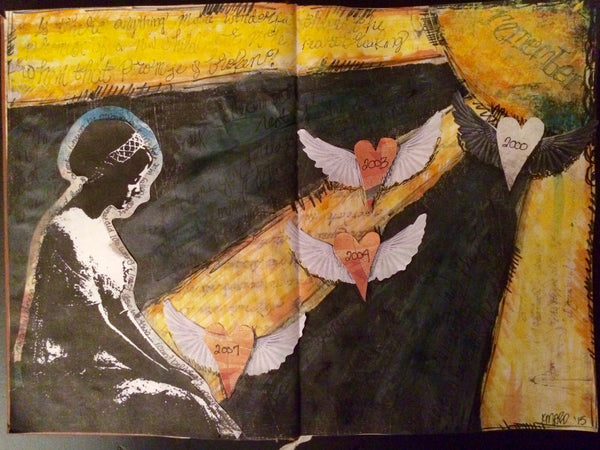Remember: Art Journaling Through Loss October 28 2015, 1 Comment
*Trigger Warning: This post contains discussions of miscarriage, stillbirth, and infant loss*
We hardly ever talk about it, not with our loved ones and certainly not in mixed company. Yet, it is with us, always. It has become a part of who we are: pregnancy and infant loss survivors. Many of us bear this weight in needless silence. Others don’t allow time to mourn at all, trying to be strong for those around us. Our losses come in many forms and no two stories are alike.There is no right or wrong way to grieve, but despite the isolation you may feel, one thing is for certain: You are not alone.
- 10-20% of all clinically recognized pregnancies end in miscarriage each year. 1
- 24,000 babies are stillborn in the United States each year. 2
- Every year 3,500 infants die from Sudden Unexpected Infant Death. 3
In 1988 Ronald Reagan declared October as Pregnancy and Infant Loss Awareness month, yet despite this proclamation almost 30 years ago, many are still entrenched in seclusion and shame, unable to share their stories. But, as author Brené Brown writes “owning our story and loving ourselves through that process is the bravest thing that we will ever do.” So, today I will be brave. I will share my story and art journal. I will live a wholehearted life and attempt to empower others to do the same.
[Remember: Created with supplies from Tangie Baxter’s Eerie Shadows Bundle and Art Journal Caravan Workshop Expedition 2014, watercolors, acrylic paint, and markers]
In 2007 I suffered a blighted ovum. Development ceased at seven weeks, but it took my body five more to catch up. And so, at 12 weeks, after heavy spotting sent me to the emergency room, I received the news that I already felt in my heart. I had lost another pregnancy.
This particular loss was different. Unlike my previous losses, this pregnancy was public knowledge. Everyone knew, everyone celebrated and congratulated me: the mommy to be. My previous pregnancies were lost early and were not disclosed to anyone but my journal. There was pain and grief, but it was mine alone to bear.
This miscarriage was incomparable. The physical pain was excruciating. My hormone levels were so off, it took my body months to return to normal. I wanted to heal and move on so desperately, but my body would just not let go. Yet, the physical pain paled in comparison to the emotional toll it took on me.
You see, it wasn’t just a pregnancy that was lost. It was the hopes and dreams tied to it. It took time to mourn a future that would never come. As with all forms of grief and loss, there is no cookie cutter solution, only time can heal. But, if I had to go through the process again, here are some places I would start:
Lean in and let yourself feel
Try not to gloss over your pain. It is hard and exhausting, but allowing yourself to take the time to truly process your emotions is so important to the healing process.
Secure your oxygen mask first
When an airplane is in distress and oxygen masks are deploy, the rule of thumb is to put on your mask first before you can help those around you. The same concept rings true here. Taking care of yourself is not selfish, you are worthy of self-care.
Seek solitude not isolation
Take time to be by yourself, but remember that you are not alone. Reaching out to friends and family who love and support you can be crucial in times of loss. If you feel like no one close to you will understand, there are many online support groups that will embrace you. Find a place where others can commiserate and celebrate your strength and courage.
Journal and create art. Often.
In the words of Tangie Baxter “It’s showing up even when we feel “uninspired” and work through it. So much can be learned, so much joy found and our minds healed through creativity.” Art journaling is a great place to begin the healing process.
Practice gratitude
It’s easy to practice gratitude when things are good. Yet, practicing gratitude is even more important during times of need. If you already have a gratitude journal, keep on writing. If you are not familiar with the practice, start by writing down five things you are grateful for every day. Studies show that those who practice gratitude are happier and healthier for it.5
Share your story
It may take days, months, or years to be able to talk about your loss. When it is time you will know. Bottling up your experience and putting it on a shelf is a great way to feed the loneliness within. Connection, awareness, and understanding bring us one step closer to defeating the sense of shame and guilt that often accompanies pregnancy loss and infant death.
Are you ready to be brave and share your story or tackle an art journal page about your loss? Please share with us in the comments below.
[posted by Karli-Marie]





Comments
Kay on November 03 2015 at 12:16PM
Karlie-Marie … your story, your heart-felt story so beautifully told and illustrated. I know you will reach others battling the struggles of life and thank you for encouraging all of us to find healing through our art. What a blessing.